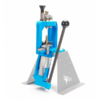Yes, I contacted Redding, and as I mentioned, I did the common tricks they and others which came before me have used to correct the issue.
It does appear, however, based on the comments made in this thread by others, the Lyman AA8 also suffers a bit from the same inherent design issue. They’re both a center support axle design which has to index over the top of a rear support column - to be supported by the column, they HAVE to start to tilt, else they don’t make contact. Using properly sized bushings for each head and shimming the rear support does help, but it’s still tilt, not float. Floating the dies does help (only time I’ve found the old style Lee lock rings to be useful), but it’s asking your die to act in a way it wasn’t intended to make up for a particular issue (read weakness) in the design of the press. It’s not so dissimilar to the shell plate tilt guys see in the Hornady LNL-AP when they’re first starting or finishing up, such there aren’t cases in every position. Nature of the beast, or rather, the design.
THR thread on T7 head tilt and bushing job
Accurateshooter thread on T7 tilt
As I said above, I don’t recommend against the press, but don’t let yourself be fooled by legends of superiority without understanding, under the green paint, it’s still simply a machine, and any machine will have inherent design characteristics - and in this case, head tilt is an inherent design characteristic.









